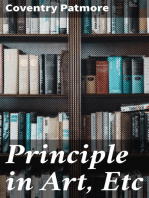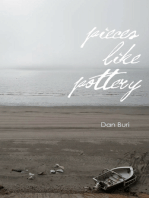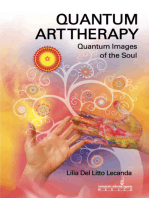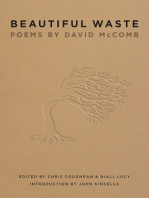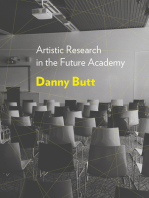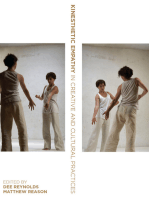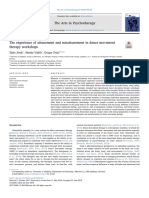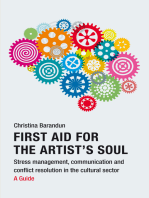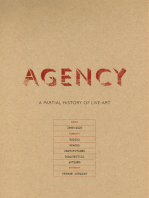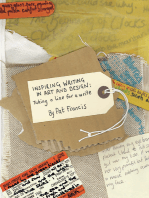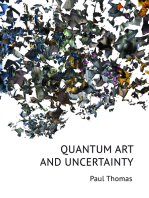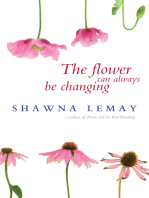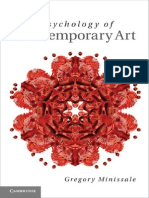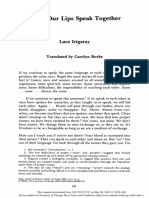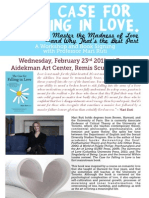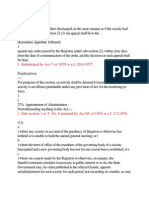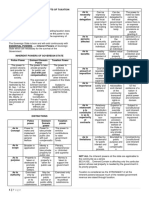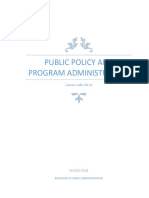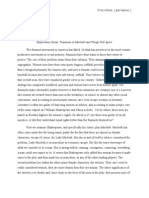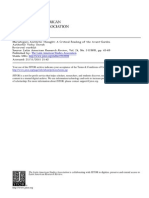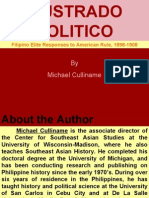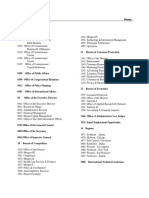Professional Documents
Culture Documents
The Idea of Intentional Practice in The Arts and in The Professions
Uploaded by
Marc ZegansOriginal Title
Copyright
Available Formats
Share this document
Did you find this document useful?
Is this content inappropriate?
Report this DocumentCopyright:
Available Formats
The Idea of Intentional Practice in The Arts and in The Professions
Uploaded by
Marc ZegansCopyright:
Available Formats
INTENTIONAL PRACTICE: A WAY OF LIVING IN THE ARTS AND THE PROFESSIONS As a creative development advisor Ive worked with
many artists and professionalsi perplexed by the question of how to live a purposeful life, one thats simultaneously coherent, pragmatic, meaningful and authentic. Ive also grappled during the past thirty years as a teacher, poet, manager and developmental advisor, with my own perplexities about these questions. During this time, Ive come to understand that a Faustian bargain lies at the heart of our confusion. The devils deal arises because we want to be free from fear and we want to feel important, so we look for an arrangement that protects us from having to look our clients, curators and collectors directly in the eye. Accordingly, we submit to an agreement whose core features are always the same, a matrix of dominance and subordination that marries our identities to a status structure in which we can feel safe and special (while relieving us of the need to display courage and the necessity to demonstrate humility) so long as we do as we are told outside our narrow realm of special expertise. It works like this. As professionals, were deferred to for our special knowledge, rewarded with incomes above the market-clearing price, and given moral permissions not granted to others.ii Yet accepting the structure that rewards us so well comes at the price of conformity and compliance. To maintain our status, we face strong pressure to passively accept the dictates of the system in which we operate and its economic reward structure, rather than maintain critical perspective and act on the guiding values we hold true. Each time we make the choice to abdicate personal responsibility in our professional roles we compromise our authenticity, because we let mores that do not reflect our true beliefs dictate our courses of action, and in the process efface ourselves. The test of whether we are so abdicating is simple; do we find ourselves rationalizing our decisions: first to ourselves and then to others?iii Like professionals, artists often wed themselves to status hierarchies, but on very different terms. For example, a surgeons professional status arises in part when the state, through licensure and certification, restricts the availability of surgical services. By contrast, art is in constant oversupply relative to the market, and artists as a group are not granted special privileges and recognition by the state, though states do create awards and sometimes sinecures for exemplary individuals.iv However, if social status does not generally attach to the role of artists, it does attach both positively and negatively to individual artists.v Status in the arts tends to form concentric circles around a small core of A-listers who share in common: the esteem of critics, curators, scholars, and peers; the ability to mobilize resources for projects; financial independence, and cultural influence. Crudely speaking, artists fall into three groups: those with sufficient reputation and market power to command deference and dictate price; those with the talent and acumen to make a living by cultivating and maintaining enough good will among tastemakers and gatekeepers to be seen as established (read, fundable), and those whose status is so diminished that they feel lucky to receive any crumbs that may fall from the table.
Copyright, Marc Zegans, 2012. All rights Reserved mycreativedevelopment.com
Entry to the top level of this hierarchy depends at least initially on the compelling nature of the artist and the artists work. Having achieved status and reputation, pressure mounts to not rock the boat, and an artist may become more concerned with maintaining the perquisites of status than with advancing the work. This is not a given, but it does happen. In the middle tier, the established artist who wishes to keep working is engaged constantly in the politics of maintaining fundable status and creating projects that provide credit-claiming opportunities for their backers.vi Those in the bottom tier are routinely made to doubt their worth, are led to believe that they ought to feel privileged if they are given anything that allows them to work, much less meaningful financial compensation. The game here is to make arts supporters feel good about themselves for doing so little, and starving supplicants willing participants in their cruel treatment. Once again, the structure of dominance and subordination pushes the work to the background. As artists and professionals we can fruitfully engage systems built on status and power, so long as we do it on our own terms. When, instead, we give ourselves over to the basic dynamic of these systems, we quickly find that we cannot successfully integrate our fundamental need for authenticity and the conduct of our work with social progress in the system. The simple and brave solution to this conundrum is to consciously adopt a way of living in the arts and the professions that eschews status distinctions in favor of working always at eye level with our counterparts be they clients, collectors, audience members, gatekeepers or patients. I call this way of working intentional practice. Intentional Practice Intentional practice becomes possible when we see our work as a calling. When work is a calling, we are not simply showing up for a job, or pursuing a passion for private purposes; we aim to make a meaningful difference, and we are eager always to become better at what we do. Seeing work as a calling takes our self-worth off the table, thus freeing us from the concerns of both status and position and the perquisites they carry. Having let go of our status attachments, we release the fear that binds us to dominance-subordination hierarchies and can now see eye to eye with anyone, speak freely, and relinquish the desire to feel better about ourselves by putting others beneath us. To better understand why work as calling forms the foundation of intentional practice, lets explore how this view of work differs seeing from work simply as a job or work as the product of private passion. Work as a job is a contractual exchange of money for service. This contract may bind us to standards of quality, effort, and productivity; it may also bind us explicitly or implicitly to general norms of professional behavior. When work is a job we do not feel called upon to go above and beyond what the contract requires (though we may take pleasure in a job well done) and we concern ourselves less with the benefits we create than with the fulfillment of our duties. When work is a calling, precisely the opposite is true, we care about meeting the genuine need that has called us to our profession or that has called us to make art. We
Copyright, Marc Zegans, 2012. All rights Reserved mycreativedevelopment.com
reach beyond ourselves to heal others, to open horizons and to create possibilities hitherto unimagined. We care about the consequences, although if we are wise, we let go the outcome. Passion pursued for private purposes (the prime mover for many working artists) is fundamentally self-involved. While artists thus engaged may sell their work and while they may open their doors to the public in the hope that they will find support sufficient to sustain them, their method of work is neither other regarding, nor consciously communicative; interests, concerns and preoccupations internal to the artist organize it instead. That such work may communicate and perhaps communicate powerfully is beside the point. The point is to make the work. Work as a calling is necessarily passionate. It shares also with working from private passion the love of process. Work as calling differs though in that it is profoundly other regarding, consciously communicative, and socially engaged. Intentional practice incorporates each of these qualities of work as a calling, but goes further, for intentional practice is not simply about following ones calling but following it well. To do so, artists and professionals cannot go blindly, they must take active responsibility for choosing their values and must cultivate their practices with selfawareness and clear conscious intent. When artists and professionals proceed accordingly, they are intentional practitioners; but how precisely does one proceed? Practicing Intentionally Intentional practice is particular to the individual. Yet, it can be helpful to think about the art of intentional practice as having seven essential qualities: 1) being active 2) taking responsibility 3) being mindful, 4) being reflective, 5) being authentic, 6) being communicative and 7) being accountable. Lets consider each idea in turn. Being Active Intentional practitioners consciously choose how they will proceed. They recognize the power of making active personal choices, and they assume responsibility for their actions. As an intentional practitioner, you determine the sort of work that does or does not suit you, based on your personal convictions and the professional and aesthetic norms to which you consciously subscribe. Knowing clearly what you are doing and why, you reach actively into the community to share what you have to offer with patients, clients and collectors who will genuinely benefit from your skill and from your work. Taking Responsibility. Intentional practitioners are not only well versed in the norms, ethics, and standards of their professions, but are actively aware of these mores. On occasion, intentional practitioners may assert standards and principles that exceed the basic professional norms of their field, or that may conflict with the prevailing consensus about such values. Unlike passive professionals, intentional practitioners, are willing to assume full responsibility for their actions, rather than taking self-interested advantage of nominal moral permissions that their professional standing may appear to grant.
Copyright, Marc Zegans, 2012. All rights Reserved mycreativedevelopment.com
Being Mindful is to bring ones attention fully to the present moment. In the context of intentional practice this is to know whats going on and to act consonantly. In this, intentional practitioners differ from those who scurry to meet the demands of the market, but are unconcerned with the net effects of their actions. Practitioners driven entirely by demand are socially responsive, but not socially responsible, because they choose to skate along the surface, rather than be fully present to the deeper reality of which they are a part. By choosing to be present to what is here now intentional practitioners develop the means to bring their work to the world skillfully in socially responsible ways. Being Reflective Any artist or professional who consciously evolves his or her practice and who uses data to inform this evolution, is a reflective practitioner.vii Being reflective is not a mode of action exclusive to intentional practitioners; however, it is necessary to effective intentional practice. Because intentional practitioners ground their work in present reality, and because they are committed to consistent improvement, continual reflection on practice is a hallmark of their trade. Being Authentic. The relationship between art, authenticity and professional practice is complex. In some respects, it is more knotted for professionals than for artists, because professionals occupy formal, socially constructed and legally sanctioned roles that confer special obligations and privileges. Professional must grapple with balancing role, self and professional persona in their daily work as a consequence of the legally privileged roles they occupy. While artists may assume roles and while they construct personas for aesthetic, self-protective and promotional reasons, such choices are individual; the coercive apparatuses of professional regulatory institutions and of the State do not routinely shape these choices as they do those made by professionals. Despite such differences, intentional practitioners in the arts and the professions share much common ground. At the center of intentional practice for both artists and professionals are two critical acts: 1) formulating a specific personal vision, and 2) choosing to achieve this vision in the context of self-selected values. As noted earlier, such values may correspond precisely to conventional social, artistic and professional norms; they may impose additional voluntary burdens (going beyond what society or the profession requires); or they may deviate from such norms in important ways. Whatever the particular content, intentional practitioners take direct and active responsibility for the visions they form, for the values they embrace, and for fulfilling their visions within the context of their chosen values. They know what they are doing and are willing to accept the consequences. viii The benefits in terms of personal integration are profound. When artists and professionals regularly accept responsibility for their actions, they shape a deep, rich, and evolving picture of who they are, one that permits them to act consistently with an evolving notion of their authentic selves.ix For intentional practitioners, consequently, being authentic or inauthentic is not a vague feeling, a sense of being or not being myself in a given situation. Rather, for them, being authentic is about actively knowing and discovering who they are, and enquiring into feelings of not being themselves in order to reveal the underlying conflict which gives such feelings rise, and to reconcile that conflict in accord with their core values and principles.x Accordingly,
Copyright, Marc Zegans, 2012. All rights Reserved mycreativedevelopment.com
intentional practitioners never have to put themselves in the deeply inauthentic position of having to rationalize their discomfort.xi Compare this genuine approach to decision-making with that of professionals who rationalize choices with statements like, thats what the market demands, or thats where the markets going to go. To allow oneself as an artist or professional to be blown by the fickle winds of the market is to give up ones responsibility to form and habitually evolve a compelling personal vision that organizes ones creative and productive life. To be purely market-driven is to render the idea of authenticity meaningless, because it is to have effaced oneself completely. Consider alternatively the standard defense against engaging the market, to engage the market is to compromise ones artistic integrity. On this view, authenticity is achieved and integrity maintained by isolation. Though this position is often voiced for selfarrogating or defensive purposesxii, it does hold some truth. Some artists and professionals will do best in a hothouse environment, protected from much of life, so that they can concentrate exclusively on what they do best. Others though will do well in the middle of the action. And most will intermix periods of engagement and isolation during the course of their careers. The proposition then that artistic vision and professional integrity are best served by isolation cannot stand as a general rule. Rather than seek comfort in this defense against engaging the outside world, intentional practitioners seek a degree of engagement appropriate to their needs, intentions and circumstances. Being Communicative. Intentional practitioners value their work, their audience, their patrons, and their clients. As artists they understand that the cycle of creativity is only complete when their work goes out into the world, and that it is only fulfilled when the work finds its natural audience. If the work is never seen, never heard, never engaged, something has been lost. Professionals who practice intentionally understand that sharing their skills with those clients who can most benefit from their work is the best way to fulfill their calling. Accordingly, intentional practitioners systematically communicate about their work to those whom it will have true meaning. Artists who practice intentionally understand that the natural audience for a given work may be one person, or it may be millions, and they are content to find this natural audience no matter how large or how small it may be; but they do not engage in magical thinking to find and attract it. Professionals understand that their aim is not simply to grow the largest possible practice, but to grow the practice that functions best for themselves and their clients. Intentional practitioners communicate with the purpose of finding and engaging only those people with whom their work is a true fit, whether it is a few clients a week or a practice that touches thousands. Simply put, intentional practitioners reach out generously to their natural audience, and they refuse to pander. Being Accountable. Intentional practitioners are accountable to themselves, to their principles, to the process of evolving as they learn more, and to the public and clients they serve. They understand that they can only be accountable if they are comfortable with themselves, and if they communicate vigorously and honestly with the world. To the extent
Copyright, Marc Zegans, 2012. All rights Reserved mycreativedevelopment.com
that intentional practitioners accept and embrace social and professional norms, they do so with conscious intent. When they offer accountability to their profession, they do so freely, not out of fear of exposure, or because they have abdicated their responsibility to think and to choose for themselves. Accountability for intentional practitioners is not grim, selfrighteous, or fastidious; it is simply the act of being true to themselves and to the people who can benefit from their work. The seven qualities of intentional practice that Ive identified are overlapping and mutually reinforcing. You will find as you adopt them that one will lead to another, and that they will inform each other. You will discover also that intentional practice operates along a continuum, you need not plunge into the approach, but at some point you may find that you have undergone a decisive shift in attitude and perspective one that brings genuine fulfillment to your work.
Copyright, Marc Zegans, 2012. All rights Reserved mycreativedevelopment.com
In this paper I argue that artists and professionals can live better through intentional practice, yet I maintain a distinction throughout. As we often talk informally about professional artists, or artists displaying professional values, the question arises, why assert and maintain this distinction? When we talk about an artist acting like a professional in this informal sense, we mean typically an artist who works for money and an artist who exercises discipline and adult responsibility in managing the business side of his or her career. In the context of collaborative artistic productions such a plays, films, dance performances and chamber music, it means acting as a good colleague. In this latter social sense, the idea of an artist maintaining professional integrity has some overlap with the idea of that which is expected of one who belongs to a formal profession. To be a professional, unlike an artist, is to enter a tribe with particular rules, regulations standards and procedures, and to agreed to be bound by these for the entire course of ones professional life, and it is to cede the right to determine ones basic career status to one or more governing groups that regulate the profession. The same is not true of artists because they nominate themselves to their roles; to the degree to which they collaborate and behave as good citizens, they are allying a rough professionalism to conduct of their work, a far cry from pledging their allegiance to a certifying group.
ii
The question of whether and when professional role legitimately mints special moral permissions is complex. For an interesting discussion of the topic see, Arthur Isak Applbaum, Ethics For Adversaries: The Morality of Roles in Public and Professional Life, (1999) Princeton University Press.
iii
When our professional actions are in alignment with our moral and aesthetic core we have no need to rationalize.
iv
The status of artists and the role of the State in the construction of culture vary widely: Ireland gives special status and privilege to writers; France makes culture a major component of national policy: Berlin has embarked on a quest to become a global arts center by engaging in a bold policy of subsidy for foreign artists willing to move to its precincts; Authoritarian regimes designate state approved art and artists. The basic relationship between artist and official status, however, is different from occupying a formally sanctioned professional role, in that being an artist is logically prior to formal role, whereas to enter a profession is to adopt a formal role. Simply put, there is something unalienable about an individuals claim to be an artist. While the state may be generous or stingy toward the arts, laud or denigrate particular artists, or ban, threaten or kill dangerous artists, fundamentally the claim to be an artist belongs to the artist him or herself. The same cannot be said of a doctor, lawyer or other licensed professional, because professional roles are at their core socially constructed. Though social construction enters into the work and the possibilities afforded to an artist, there is something primal that belongs entirely to the individual or individuals making the work, and this can neither be alienated from an individual making art, nor awarded to an individual who does not: the title is rescindable; the calling is not.
v
While artists may assign themselves status as a group apart, this designation is informal and does not carry social currency except in the minds of artists themselves, of those who wish they were, and those who derive pleasure from knowing that artists exist.
vi
Indeed the term established artist, a designation useful only to funders, has everything to do with the resume of the artist and nothing to do with the making or the development of the work.
vii
For the classic statement of reflective practice, see Donald Schn, The Reflective Practitioner: How
Professionals Think in Action, (1983) and Basic Books.
viii
That intentional practitioners operate from personal vision does not imply that they dont integrate useful feedback into their decision-making. Intentional practitioners are conscious and socially engaged, but being socially engaged is different from being socially driven. Intentional practitioners listen well, but do not abdicate personal responsibility for the narrative arc that defines their careers.
ix
Because we can sort out value conflicts by seeking and operating from higher principles, or by examining situations in detail to determine which of two or more conflicting values ought to decide the matter at hand, we avoid being in conflict with ourselves, and act in a self-consistent manner.
x
On deeper reflection one might reconcile the conflict by revising the underlying values and principles themselves.
xi
Commenting on an early draft of this paper my colleague Jenny DeBell asked me to clarify the distinction between inauthenticity and compromise. In this connection its helpful to draw a distinction between compromising oneself and making a compromise in a given situation. To compromise oneself is to consciously choose to impair ones identity and ones highest principles in service of lesser ends, typically in the form of extrinsic rewards. To compromise in a situation while holding oneself and ones higher principles intact is very much part of engaged and authentic practice. An artist must come to terms with his or her materials in order to make something real in the world; we all must contend with budgets and resource constraints; collaboration among people who bring different values and perspectives requires methods that all can agree to if the work is to be done; achieving valuable local effects while managing from a distance requires deferring to local values in many things while preserving core commitments and principles that give guidance to the application of such values. Authenticity is not lost in comprise, indeed to compromise well, we must be clear about who we are and about those things to which we will sensibly agree and those to which we will not. xii Often, our claim that authenticity and integrity demand distance from the world is a rationale to cover ones fear of engagement. When such claims are based in fear, there is nothing authentic about them. We are using a ploy to protect ourselves from finding out how good we really are, what we can do when we have resources, and what we will do when we dont. If we know ourselves well, and we understand that in our particular case we need buffers to thrive, then so be it. But if at bottom we find fear, then it may be helpful to abandon the argument that integrity lies in refusing the outside world, and to begin mastering our fears.
You might also like
- The Jerry Saltz Abstract Manifesto, in Twenty Parts: Robert Ryman Agnes MartinDocument2 pagesThe Jerry Saltz Abstract Manifesto, in Twenty Parts: Robert Ryman Agnes MartinAlfredo VillarNo ratings yet
- Provoking the Field: International Perspectives on Visual Arts PhDs in EducationFrom EverandProvoking the Field: International Perspectives on Visual Arts PhDs in EducationNo ratings yet
- 2) Cyborg Manifesto - Donna HarawayDocument2 pages2) Cyborg Manifesto - Donna Harawayrayrod614No ratings yet
- Loveless PracticeFleshTheoryDocument16 pagesLoveless PracticeFleshTheoryPedro GoisNo ratings yet
- Art Based Research Article 2Document17 pagesArt Based Research Article 2Aline LoureiroNo ratings yet
- Clay Qualities Benefits and Therapeutic Applications A LiteratDocument32 pagesClay Qualities Benefits and Therapeutic Applications A LiteratTania Fernanda Gantiva VanegasNo ratings yet
- Conceptual Art ExplainedDocument5 pagesConceptual Art Explainedoxotnic100% (1)
- DUCHAMP'S VIEWS ON THE CREATIVE ACTDocument3 pagesDUCHAMP'S VIEWS ON THE CREATIVE ACTMattia CapellettiNo ratings yet
- Passages: Moving beyond liminality in the study of literature and cultureFrom EverandPassages: Moving beyond liminality in the study of literature and cultureElizabeth KovachNo ratings yet
- The Practice Chart for Intention Centered Yoga and Art TherapyDocument16 pagesThe Practice Chart for Intention Centered Yoga and Art TherapyBalázs TóthNo ratings yet
- Repetition Compulsion PDFDocument5 pagesRepetition Compulsion PDFJJNo ratings yet
- Art Practice As Fictioning (Or, Myth-Science) : Simon O'SullivanDocument10 pagesArt Practice As Fictioning (Or, Myth-Science) : Simon O'SullivanSimon O'SullivanNo ratings yet
- Bolt - Performative Research ParadigmDocument12 pagesBolt - Performative Research ParadigmCatalin BryllaNo ratings yet
- Day Book Anne TruittDocument6 pagesDay Book Anne TruittAngga Vlamino100% (1)
- The Mind of the Artist Thoughts and Sayings of Painters and Sculptors on Their ArtFrom EverandThe Mind of the Artist Thoughts and Sayings of Painters and Sculptors on Their ArtNo ratings yet
- Kinesthetic Empathy in Creative and Cultural PracticesFrom EverandKinesthetic Empathy in Creative and Cultural PracticesDee ReynoldsNo ratings yet
- Attunement MisattunementDocument8 pagesAttunement MisattunementVeron PabonNo ratings yet
- First Aid for the Artist's Soul: Stress management, communication and conflict resolution in the cultural sector. A GuideFrom EverandFirst Aid for the Artist's Soul: Stress management, communication and conflict resolution in the cultural sector. A GuideNo ratings yet
- Ocean Vuong On Being Generous in Your WorkDocument7 pagesOcean Vuong On Being Generous in Your WorkNhat NamNo ratings yet
- Agency: A Partial History of Live ArtFrom EverandAgency: A Partial History of Live ArtTheron SchmidtNo ratings yet
- Worldmaking as Techné: Participatory Art, Music, and ArchitectureFrom EverandWorldmaking as Techné: Participatory Art, Music, and ArchitectureNo ratings yet
- E.Kramer Art Therapy & Artist MeaningsDocument5 pagesE.Kramer Art Therapy & Artist Meaningsagnes windramNo ratings yet
- Art Based Research Methods BookDocument300 pagesArt Based Research Methods BookIsidro100% (1)
- Transforming The Invisible: The Postmodernist Visual Artist As A Contemporary Mystic - A Review Christine HaberkornDocument25 pagesTransforming The Invisible: The Postmodernist Visual Artist As A Contemporary Mystic - A Review Christine HaberkornJohn MichaelNo ratings yet
- Insight: Creative Systems Theory's Radical New Picture of Human PossibilityFrom EverandInsight: Creative Systems Theory's Radical New Picture of Human PossibilityNo ratings yet
- On Repetition in Ragnar Kjartansson and PDFDocument3 pagesOn Repetition in Ragnar Kjartansson and PDFBrett SmithNo ratings yet
- Uncanny:Sculpture:The Body When Is A Home Not A Home? Domestic Space and The Feminine Uncanny in The Works of Louise Bourgeois and Claude CahunDocument14 pagesUncanny:Sculpture:The Body When Is A Home Not A Home? Domestic Space and The Feminine Uncanny in The Works of Louise Bourgeois and Claude CahunLucyMiddletonNo ratings yet
- Reimagining ArtivismDocument30 pagesReimagining ArtivismFermina DazaNo ratings yet
- Poster MakingDocument15 pagesPoster MakingSOURABH BiswasNo ratings yet
- Precarious Constructions - Nicolas BourriaudDocument8 pagesPrecarious Constructions - Nicolas BourriaudElif DemirkayaNo ratings yet
- Art Therapy Spot: Happiness Group & The Art of ForgivenessDocument3 pagesArt Therapy Spot: Happiness Group & The Art of ForgivenessSimonetta MangioneNo ratings yet
- Step Into A Blue Funk - Transversal Color and Derek Jarmans Blue PDFDocument76 pagesStep Into A Blue Funk - Transversal Color and Derek Jarmans Blue PDFAnjitha JoviaLNo ratings yet
- Ortega Exiled Space In-Between SpaceDocument18 pagesOrtega Exiled Space In-Between Spacevoicu_manNo ratings yet
- UK Art Therapy Practice-Based Guidelines For Children and Adults With Learning DisabilitiesDocument12 pagesUK Art Therapy Practice-Based Guidelines For Children and Adults With Learning DisabilitiesLNo ratings yet
- Curriculum: Contemporary Art Goes to SchoolFrom EverandCurriculum: Contemporary Art Goes to SchoolJennie GuyNo ratings yet
- ThePsyOfConArt PDFDocument410 pagesThePsyOfConArt PDFmolutttNo ratings yet
- Art January 2014Document37 pagesArt January 2014ArtdataNo ratings yet
- Molesworth House Work and Art WorkDocument28 pagesMolesworth House Work and Art WorkLeah WolffNo ratings yet
- When Our Lips Speak Together PDFDocument11 pagesWhen Our Lips Speak Together PDFTazz GeeNo ratings yet
- Berger - Ways of SeeingDocument27 pagesBerger - Ways of SeeingJosephKingston100% (1)
- Case Falling in LoveDocument1 pageCase Falling in Lovekaushik_ranjan_2No ratings yet
- ארכיטיפיםDocument71 pagesארכיטיפיםlev2468No ratings yet
- What A Body Can DoDocument26 pagesWhat A Body Can DoMariana Romero Bello100% (1)
- Quick and Dirty Answers to the Biggest of Questions: Creative Systems Theory Explains What It Is All About (Really)From EverandQuick and Dirty Answers to the Biggest of Questions: Creative Systems Theory Explains What It Is All About (Really)No ratings yet
- Journal of Visual Culture: Translating The Essay Into Film and Installation Nora M. AlterDocument14 pagesJournal of Visual Culture: Translating The Essay Into Film and Installation Nora M. AlterLais Queiroz100% (1)
- The Karnataka Societies Registration Act, 1960Document6 pagesThe Karnataka Societies Registration Act, 1960Madhura KulkarniNo ratings yet
- DMDK v. Election Commission of India (2012) 7 SCC 340 (Case Comment)Document6 pagesDMDK v. Election Commission of India (2012) 7 SCC 340 (Case Comment)fareed rafiqiNo ratings yet
- Everyday StalinismDocument22 pagesEveryday Stalinismamru56No ratings yet
- Abstract of GlobalisationDocument17 pagesAbstract of Globalisationdhruvgupta1990No ratings yet
- US Supreme Court JudgmentDocument2 pagesUS Supreme Court JudgmentPamela FunesNo ratings yet
- An Introduction To Roman Dutch LawDocument556 pagesAn Introduction To Roman Dutch LawSimu JemwaNo ratings yet
- (1918) The Mulatto in The United States: Including A Study of The Role of Mixed-Blood Races Throughout The WorldDocument428 pages(1918) The Mulatto in The United States: Including A Study of The Role of Mixed-Blood Races Throughout The WorldHerbert Hillary Booker 2nd100% (2)
- Taxation NotesDocument27 pagesTaxation NotesRound RoundNo ratings yet
- Https Indiapostgdsonline - in Gdsonlinec3p4 Reg Print - AspxDocument1 pageHttps Indiapostgdsonline - in Gdsonlinec3p4 Reg Print - AspxALWIN JohnNo ratings yet
- Corbridge Competing InequalitiesDocument25 pagesCorbridge Competing Inequalitiesmolly786No ratings yet
- Creation of Disaster Council and Funds for Fire VictimsDocument16 pagesCreation of Disaster Council and Funds for Fire VictimsAndrewsNo ratings yet
- Module in Public Policy and Program AdministrationDocument73 pagesModule in Public Policy and Program AdministrationRommel Rios Regala100% (20)
- nOTes Int RelDocument12 pagesnOTes Int RelDua BalochNo ratings yet
- Flowchart Remedies of A TaxpayerDocument2 pagesFlowchart Remedies of A TaxpayerGENEVIE TALANG0% (1)
- 如何培養一個真正的雙語寶寶 - 紐約時報 國際生活Document3 pages如何培養一個真正的雙語寶寶 - 紐約時報 國際生活Melody Tsz Ching NgNo ratings yet
- Lower Caste Citizens and The PoliceDocument9 pagesLower Caste Citizens and The PoliceSAMEEKSHA SUDHINDRA HOSKOTE 2133361No ratings yet
- Feminism in Macbeth and Things Fall ApartDocument3 pagesFeminism in Macbeth and Things Fall ApartJames CheungNo ratings yet
- Debates On End of Ideology & End of History PDFDocument12 pagesDebates On End of Ideology & End of History PDFAadyasha MohantyNo ratings yet
- Mariategui Aesthetic ThoughtDocument26 pagesMariategui Aesthetic ThoughtSandra ManuelsdóttirNo ratings yet
- By Michael Culliname: Filipino Elite Responses To American Rule, 1898-1908Document14 pagesBy Michael Culliname: Filipino Elite Responses To American Rule, 1898-1908kajerome2004No ratings yet
- Adarsh Housing Scam RevealedDocument8 pagesAdarsh Housing Scam RevealedrajNo ratings yet
- CHAPTER 3 Elements of State Nort Cotabato vs. GRPDocument2 pagesCHAPTER 3 Elements of State Nort Cotabato vs. GRPAmielle CanilloNo ratings yet
- FTC DirectoryDocument26 pagesFTC Directoryjavvco0% (1)
- Joya V PCGGDocument2 pagesJoya V PCGGChristina AureNo ratings yet
- TheMuslim500 2020 Low PDFDocument292 pagesTheMuslim500 2020 Low PDFKing Hawk0% (1)
- Tung Chin Hui V RodriguezDocument4 pagesTung Chin Hui V Rodriguezabbiemedina100% (1)
- A Cross-Cultural Study of Corporate ResponseDocument239 pagesA Cross-Cultural Study of Corporate Responsekenya106No ratings yet
- List of Ministers of Bangladesh 2019Document3 pagesList of Ministers of Bangladesh 2019GolamKibriabipuNo ratings yet
- 1914 Germany-Afrikaaner Boer AgreementDocument7 pages1914 Germany-Afrikaaner Boer AgreementOliveros2012100% (1)

